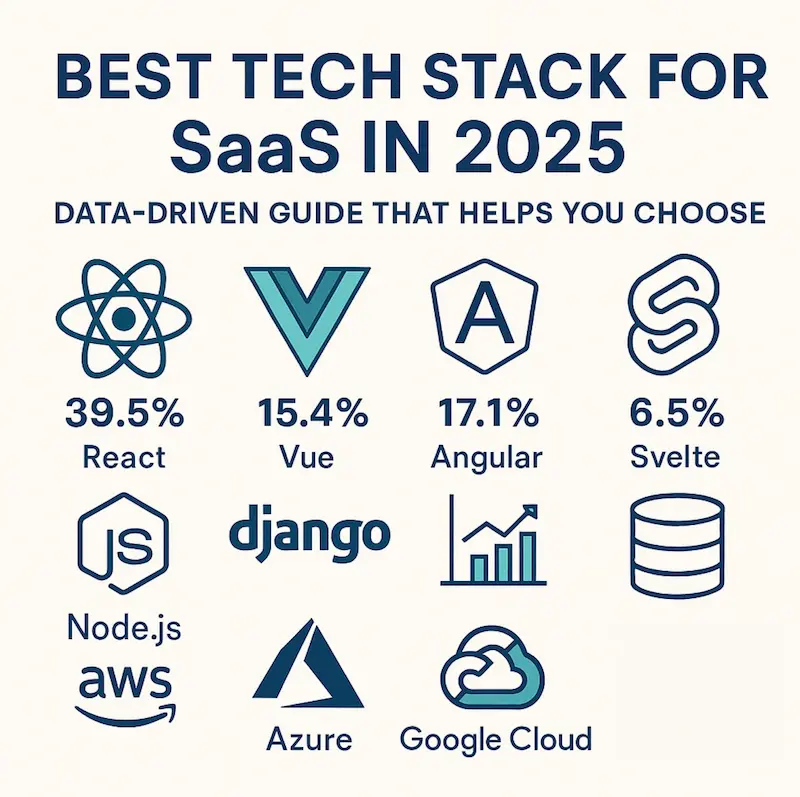Best Tech Stack for SaaS in 2025: The Data-Driven Guide That Actually Helps You Choose
Discover the best tech stack for SaaS development in 2025. Data-driven analysis of React vs Angular vs Vue, Node.js vs Django, PostgreSQL vs MongoDB, and AWS vs Azure.

The SaaS market is exploding. We're talking $1.25 trillion by 2034 with enterprises growing at 19.2% this year alone. But here's the problem: with 400+ database systems and countless framework combinations, choosing your tech stack feels like picking a lottery ticket.
This isn't another "my favorite framework" article. This is what the data actually says about building SaaS applications in 2025.
The Frontend Reality Check
React: Still King, But Losing Ground
Market Share: 39.5% (down from 40.58% in 2023)
The Reality: React had its first decline in popularity this year, dropping 6.3%.
But with 233k GitHub stars and 32 million weekly NPM downloads, it's still the safe bet.
Choose React if: You need maximum hiring flexibility, extensive ecosystem, or you're building complex user interfaces. The job market loves React developers.
Vue.js: The Goldilocks Framework
Market Share: 15.4% with 60.2% developer satisfaction
The Reality: Vue strikes the perfect balance between React's flexibility and Angular's
structure. It's approachable but powerful.
Choose Vue if: Your team values simplicity and you want to ship fast without sacrificing scalability.
Angular: The Enterprise Workhorse (With Problems)
Market Share: 17.1%, but here's the concerning part: 49% of developers say
they're not interested in learning it
The Reality: Angular's steep learning curve is pushing developers away, but it still
dominates enterprise environments.
Choose Angular if: You're building large-scale enterprise applications and have a dedicated team willing to climb the learning curve.
Svelte: The Rising Star
Market Share: Only 6.5%, but 72.8% developer satisfaction (highest of all
frameworks)
The Reality: Nearly 50% of developers want to learn Svelte. It compiles to vanilla
JavaScript, eliminating virtual DOM overhead.
Choose Svelte if: Performance is critical and you're willing to bet on the future.
Backend: Where the Real Work Happens
Node.js/Express: The JavaScript Everywhere Solution
Status: Node.js overtook React as the most-used web framework in 2024
Why It Works: One language across your entire stack. Massive ecosystem. Real-time
capabilities built-in.
Perfect for: Real-time applications, rapid prototyping, teams already strong in JavaScript.
Django: The Python Powerhouse
Market Position: Named the most popular backend framework by developers
The Numbers: Python ranks 4th among programming languages at 48.07% adoption
Perfect for: Data-heavy applications, AI/ML integration, rapid development with built-in admin panels.
The Verdict
Choose Node.js if you want JavaScript everywhere and real-time features. Choose Django if you need rock-solid reliability and plan to integrate AI/ML features.
Database: Your Data Foundation
PostgreSQL: The New Champion
Market Share: 48.7% (overtook MySQL)
Why It's Winning: Object-relational capabilities, JSON support, and rock-solid reliability.
It's what serious developers choose.
MySQL: Still Fighting
Market Share: 40.3%
Still Good For: Simple web applications, tight budgets, teams already familiar with
it.
MongoDB: NoSQL When You Need It
Reality Check: Most popular document database, 100x faster than traditional
RDBMS for certain use cases
Choose MongoDB if: Your data structure is unpredictable or you need rapid iteration.
The Smart Move: Start with PostgreSQL. It handles 90% of use cases and you can always add MongoDB later for specific needs.
Cloud Infrastructure: Where Your SaaS Lives
AWS: Still the King
Market Share: 31-33%
Why It Leads: Most mature ecosystem, deepest service catalog, best documentation.
Azure: The Enterprise Favorite
Market Share: 21-24%
Interesting Fact: 81% of enterprises use Azure vs 79% using AWS. Microsoft's enterprise
relationships are paying off.
Google Cloud: The AI Specialist
Market Share: 10-12%
Sweet Spot: AI workloads, analytics, and developer tools.
Reality Check: 98% of companies use cloud services. The question isn't "if" but "which combination." For detailed comparisons, check out the latest Stack Overflow Developer Survey results.
The 2025 Decision Framework
For Startups (Speed to Market)
Frontend: React or Vue
Backend: Node.js/Express
Database: PostgreSQL
Cloud: AWS (most tutorials and resources)
For Enterprise (Scale & Reliability)
Frontend: React or Angular
Backend: Django or .NET
Database: PostgreSQL + Redis
Cloud: Multi-cloud (AWS + Azure)
For AI-Heavy SaaS
Frontend: React
Backend: Django/FastAPI
Database: PostgreSQL + Vector DB
Cloud: Google Cloud + AWS
The Bottom Line
The data doesn't lie: React + Node.js + PostgreSQL + AWS remains the safest, most hireable, most scalable combination for most SaaS applications in 2025. If you're looking for practical implementation guidance, the Microsoft Web Development curriculum offers excellent hands-on examples.
But here's what the statistics can't tell you: the best tech stack is the one your team can actually build, deploy, and maintain successfully.
A Final Reality Check
Could you technically build a SaaS with PHP and MySQL? Sure. With C++ and SQLite? Absolutely. Heck, someone probably built a SaaS in COBOL last week.
But just because you can doesn't mean you should. That's like using a sledgehammer to hang a picture frame – technically possible, but you'll spend more time explaining your choices than shipping features. Sometimes the beaten path isn't beaten because it's boring; it's beaten because it works.
Your customers don't care about your clever tech choices. They care about whether your product solves their problems reliably, quickly, and without crashing. For architectural best practices that actually matter to users, explore the comprehensive AWS Well-Architected Framework.
Now stop overthinking and start building. The perfect tech stack is the one that ships. The best time to start was yesterday. The second-best time is right now.
Pick your stack, build your MVP, and let real users tell you what needs optimizing. That's how every successful SaaS actually gets built.